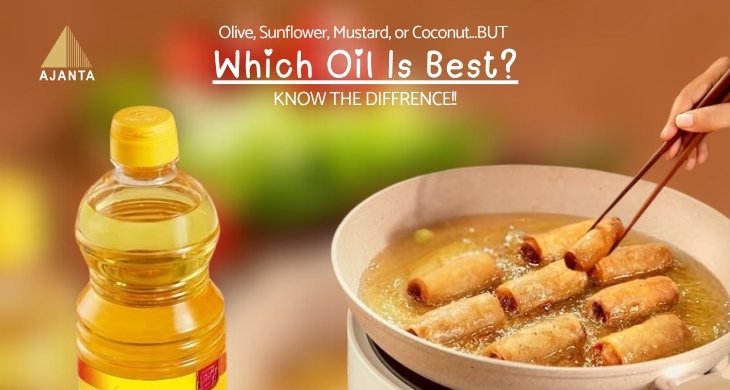Every shelf in the supermarket screams “heart-healthy,” “organic,” “low cholesterol”—but do we really know what we’re buying?
In a market flooded with choices, understanding your cooking oil can mean the difference between good health & hidden harm.
Why It’s Confusing: The Oil Overload
Every week, there’s a new brand, a new name, or a new promise. “Heart-friendly,” “light oil,” “virgin,” “refined,” “first-pressed”—sound familiar?
Many of these terms are marketing-first, health-second. And with Indian households traditionally using multiple types of oils for different dishes, the confusion only multiplies.
That’s why, before you make a choice, you need to understand what actually makes an oil good.
Elements of a Good Cooking Oil
Not every oil is suited for every cooking method. Here’s what makes an oil healthy and safe for consumption:
✔ Smoke Point Matters
- Oils break down and release harmful compounds when heated beyond their smoke point.
- For high-heat cooking (frying, deep-frying), choose oils with high smoke points like mustard oil, or refined sunflower, soybean oil.
- For low-heat cooking (sautéing, dressings), opt for coldpressed oil.
✔ Fatty Acid Composition
- Monounsaturated fats (MUFA) & Polyunsaturated fats (PUFA) (like omega-3 & omega-6) are heart-healthy. Found in olive oil, and soybean oil.
- Saturated fats (coconut oil, ghee) should be consumed in moderation.
- Avoid oils with trans fats (often found in hydrogenated oils).
✔ Processing & Purity
- Cold-pressed or extra virgin oils retain more nutrients. However their benefits depend on your cooking style.
- Refined oils undergo processing, but have more shelf life and better for high heat cooking.
Which Oil Does What?
| Oil Type | Smoke Point | Best Use | Health Benefits | Notes |
| Mustard Oil (Kachi Ghani) | High (250°C) | Deep frying, pickling | Anti-inflammatory, heart-friendly, aids digestion | Strong aroma, cold-pressed preferred |
| Sunflower Oil | High (232°C) | Frying, sautéing | High in Vitamin E, light for digestion | Ensure it’s high-oleic or cold-pressed |
| Soybean Oil | Medium-High (234°C) | All-purpose cooking | Omega-3 rich, zero cholesterol | Opt for refined if cooking at high heat |
| Groundnut Oil | High (225°C) | Deep frying, Indian cooking | Rich in MUFA, good for heart health | Cold-pressed version is best |
| Rice Bran Oil | High (232°C) | Stir fry, curries | Contains oryzanol, helps lower bad cholesterol | Great for mixed-use cooking |
| Coconut Oil | Medium (177°C) | Baking, light sautéing | Antimicrobial, good for skin and hair | High in saturated fats, use moderately |
| Olive Oil (Extra Virgin) | Low (160°C) | Salad dressing, low-heat cooking | Rich in antioxidants, heart-healthy | Not ideal for Indian high-heat cooking |
What You Should Be Concerned About While Buying Cooking Oil
Label Reading: Don’t just go by the front label—check the ingredient list, source, and extraction method.
Blend Confusion: Many brands mix oils and market them as healthier. Always understand what’s being blended.
Fake & Adulterated Oils: Especially in unbranded or street markets—check for certifications like FSSAI, non-GMO, and lab-tested.
One Oil Doesn’t Fit All: Indian cooking involves varied temperatures and techniques. One oil may not meet all needs. Choose as per your cooking purpose.
How to Not Overdo It: Tips to Balance Oil Usage
- Measure Your Oil : Use a spoon instead of pouring directly from the bottle.
- Try Alternative Cooking Methods : Steam, grill, or bake instead of deep-frying.
- Switch to Non-Stick Cookware: Helps you use less oil.
- Reuse Oil Wisely : Never reuse oil more than 2 times
- Balance meals with Whole Foods : Nuts, seeds, provide healthy fats naturally, reducing reliance on cooking oils.
- Watch for Hidden Oils: Packaged snacks, street food, even some pickles contain large quantities of unhealthy oils. Make your meals at home to control the quantity and quality.
You don’t need to become a nutritionist, but you do need to become a smart buyer.
Choosing the right cooking oil is about balance, variety, and knowledge.
Stick to 1–2 types that complement your cooking style, rotate occasionally, and most importantly—don’t overdo it.
Bonus Tip: What We Recommend
At Ajanta, we believe in transparency, purity, and tradition. Whether you choose Kachi Ghani Mustard Oil for bold flavors or Soyabean Oil for light everyday cooking — let your oil do more than just cook. Let it care.
You don’t need to become a nutritionist, but you do need to become a smart buyer.
Choosing the right cooking oil is about balance, variety, and knowledge.
Stick to 1–2 types that complement your cooking style, rotate occasionally, and most importantly—don’t overdo it.
Bonus Tip: What We Recommend
At Ajanta, we believe in transparency, purity, and tradition. Whether you choose Kachi Ghani Mustard Oil for bold flavors or Soyabean Oil for light everyday cooking — let your oil do more than just cook. Let it care.
Start your healthy journey today

